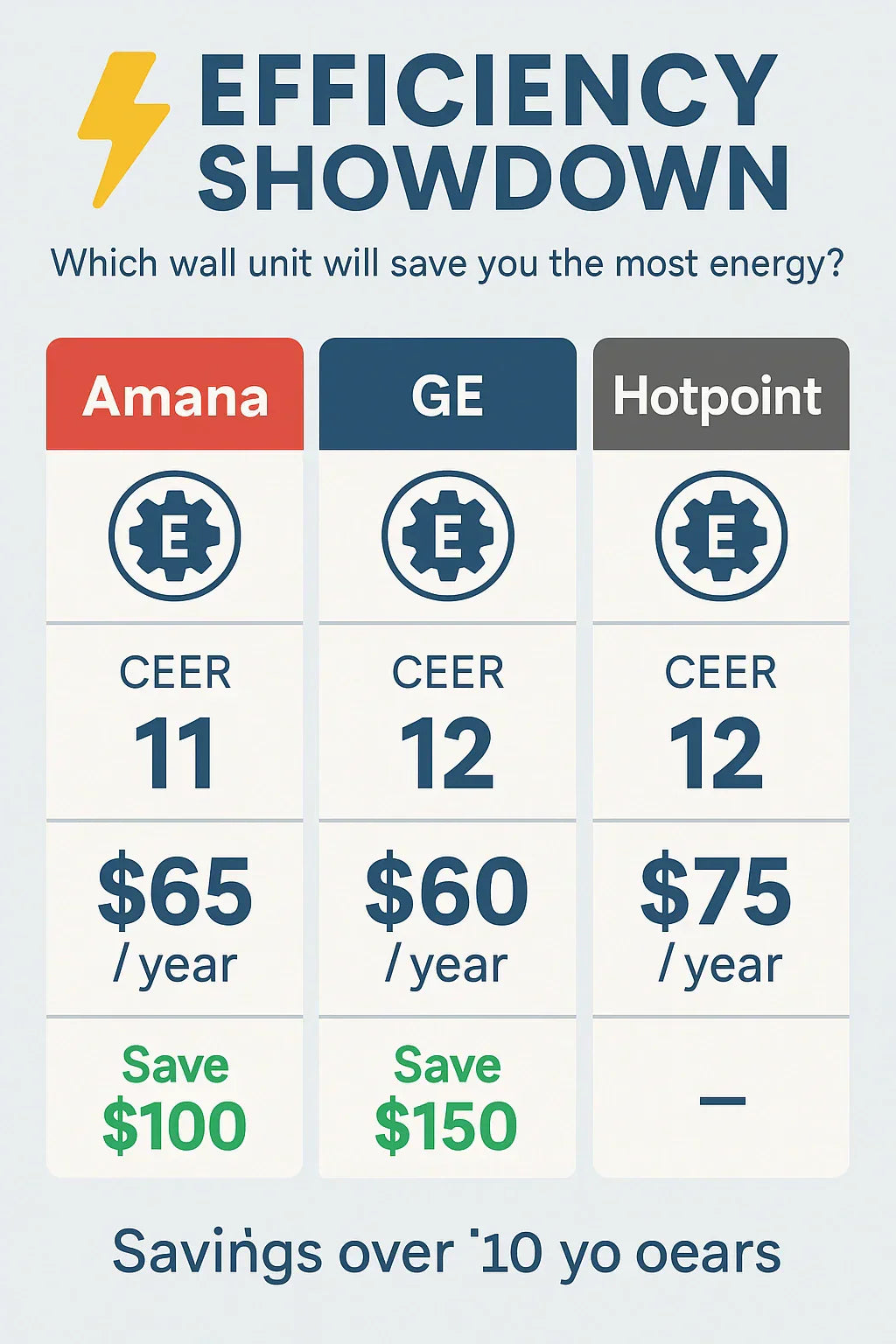When most homeowners think about choosing a new Amana, GE, or Hotpoint wall unit, the first question that comes to mind is: How much will this cost me upfront?
But here’s the real question you should ask: How much will this cost me to run, year after year?
That’s where energy efficiency comes in. The more efficient your unit, the less electricity it uses to deliver the same comfort. Over 10+ years, the difference between a budget Hotpoint and a high-efficiency GE could add up to hundreds (or even thousands) of dollars in utility bills.
In this guide, I’ll break down how efficiency ratings work, compare Amana, GE, and Hotpoint side by side, and show you which brand puts the most money back into your pocket.
📊 Understanding Efficiency Ratings
To compare units fairly, you need to know the metrics:
-
EER (Energy Efficiency Ratio) – Cooling output (BTUs) divided by power input (watts). The higher, the better.
-
CEER (Combined Energy Efficiency Ratio) – Like EER, but includes standby and off-mode power use. Adopted by EnergyStar.
-
SEER (Seasonal Energy Efficiency Ratio) – Mostly used for central AC, but some Amana and GE units report seasonal efficiency.
👉 According to the U.S. Department of Energy, CEER is the most accurate rating for room and wall units.
💡 Rule of thumb: An EER/CEER of 10 or higher is considered good.
🔴 Amana Efficiency: Steady & Reliable
Amana units are built tough—and they hold their own in efficiency:
-
Typical EER/CEER ratings: 9.5–11.0
-
EnergyStar models available: Yes, especially newer PTACs and heat pump models.
-
Smart features: Basic digital thermostats; fewer advanced controls.
-
Real-world cost to run: About $120–$180 per year for a mid-size unit.
💡 Amana’s strength is in balance: reliable performance, solid warranty coverage, and good (not groundbreaking) efficiency.
👉 Check Amana’s official HVAC lineup for EnergyStar-certified models.
🔵 GE Efficiency: The Industry Leader
If efficiency is your top concern, GE is hard to beat.
-
Typical EER/CEER ratings: 10.5–12.5 (among the best in class).
-
EnergyStar certifications: Common across their Zoneline PTACs.
-
Smart features: Wi-Fi control, energy management systems, occupancy sensors.
-
Real-world cost to run: About $100–$160 per year for a mid-size unit.
💡 GE is popular in hotels and multi-family housing for a reason: their high efficiency + durability = lower operating costs year after year.
👉 Explore GE Zoneline PTAC models.
⚪ Hotpoint Efficiency: Budget Today, Cost Tomorrow
Hotpoint is the budget-friendly brand in this lineup. But lower upfront cost often comes at the expense of efficiency.
-
Typical EER/CEER ratings: 8.5–9.5
-
EnergyStar certifications: Few models qualify.
-
Smart features: None—basic mechanical or digital controls.
-
Real-world cost to run: About $160–$220 per year for a mid-size unit.
💡 If you’re on a tight budget, Hotpoint makes sense. But over 10 years, the extra electricity could cost more than you saved upfront.
🧮 Real-World Energy Costs Compared
Here’s how the annual electricity use stacks up for a 12,000 BTU unit running 8 hours a day for 4 months:
| Brand | Avg. CEER | Annual kWh Use | Est. Annual Cost* |
|---|---|---|---|
| Amana | 10.0 | ~1,200 kWh | $150 |
| GE | 11.5 | ~1,050 kWh | $130 |
| Hotpoint | 9.0 | ~1,400 kWh | $175 |
*Based on national average electricity rate of $0.13/kWh.
👉 Use the EnergyStar savings calculator to estimate your own cost.
💡 Over 10 years, GE could save you $400–$500 compared to Hotpoint.
💲 Rebates & Tax Credits
Efficiency isn’t just about monthly bills—it’s also about incentives.
-
Federal tax credits (2025) → Up to 30% of cost back for EnergyStar-certified units under the Inflation Reduction Act.
-
Utility rebates → $50–$300 per unit, depending on your state.
-
Amana → Many models qualify.
-
GE → Strong EnergyStar presence = high eligibility.
-
Hotpoint → Limited rebate opportunities.
💡 Tip: Always check the DSIRE database for your state’s current programs.
🎨 Smart Design = Energy Savings
Don’t forget: efficiency isn’t just about the rating—it’s about how you use it.
-
Amana → Simple design, but solid insulation when properly sealed.
-
GE → Smart thermostats and occupancy sensors save money automatically.
-
Hotpoint → No smart features—manual use only.
👉 According to Energy.gov, even a small air leak around the sleeve can cut efficiency by 20%.
📊 Brand Efficiency Face-Off
| Feature | Amana | GE | Hotpoint |
|---|---|---|---|
| Avg. CEER | 10.0 | 11.5 | 9.0 |
| EnergyStar % | Moderate | High | Low |
| Smart Features | Basic | Advanced | None |
| Annual Cost | $150 | $130 | $175 |
| Best For | Balanced buyers | Efficiency-focused | Budget shoppers |
📝 Samantha’s Final Thoughts
When I compare these brands, here’s the bottom line:
-
GE is the clear winner if you want to maximize efficiency and cut utility bills. Over a decade, the savings really add up.
-
Amana strikes a good balance—solid efficiency plus great warranty coverage.
-
Hotpoint is cheapest upfront, but you’ll likely pay more in the long run on your electric bill.
So if you’re making the decision today, ask yourself: Do I want to save now—or save later?
For most homeowners, investing in GE or Amana pays off both in comfort and in your wallet.
In the next topic we will know more about: Best Accessories for Amana, GE & Hotpoint Units: Wall Sleeves, Smart Controls & Heat Kits







